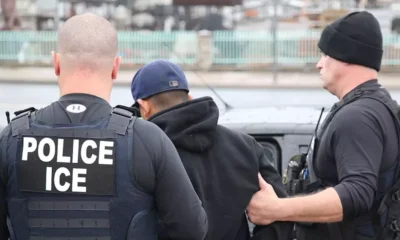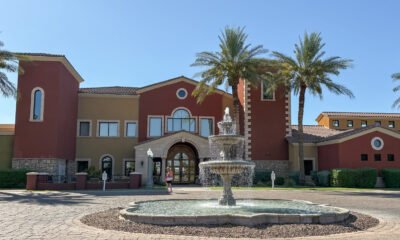Immigration
Chaos Erupts as ICE Officials Sweep Through Immigration Court in Phoenix, Arresting Multiple Individuals

Federal agents conducted multiple arrests at the immigration court in Phoenix on Tuesday, an event that one attorney characterized as “mayhem.” Attendees mistook the dismissal of their cases for an end to legal troubles, only to find themselves apprehended outside the courthouse.
Issac Ortega, an immigration attorney based in Phoenix, confirmed that agents detained his client following a Tuesday morning hearing. According to Ortega, the agents, who wore masks, refused to disclose their specific agency affiliations, identifying only as federal officers.
After the arrest, Ortega’s client was transported to a processing center within Phoenix. It remained uncertain by Tuesday evening whether he would be sent to an immigration detention facility in Eloy, Florence, or elsewhere.
Footage from outside the courthouse depicted several agents congregating around unmarked vehicles, their faces obscured. Ortega emphasized that his client had no criminal history and had entered the U.S. through the CBP program, which facilitates asylum application procedures.
“He was preparing for a credible fear interview when he was taken,” Ortega stated. Under federal law, immigrants have one year to file and pursue asylum claims post-entry.
As the situation unfolded, Immigration and Customs Enforcement (ICE) largely refrained from commenting on the arrests. Reports emerged from across the nation, indicating that similar detentions were occurring in courts in cities like Los Angeles. Here, ICE agents reportedly alerted others when cases were dismissed, raising concerns about an accelerated deportation process.
This wave of arrests aligns with prior directives from the Trump administration, which prioritized immigration enforcement involving not just ICE but also other federal agencies such as the FBI and U.S. Marshals. This approach has seen increased enforcement activities even targeting vulnerable populations, including families taking in unaccompanied minors.
Ortega’s client is a Venezuelan man in his twenties who arrived in the U.S. last fall via the CBP One program. Designed to streamline asylum claims, the program had already faced criticism, with accusations that it became a tool for expedited deportations under the previous administration.
Despite the alleged benefits of the CBP One program, the Trump administration canceled all appointments on January 20, affecting hundreds already waiting. Many migrants found themselves detained instead, a situation that has sown confusion and frustration among those seeking legal refuge.
Ortega relayed the sentiment of his client, who felt disoriented by the rapidly shifting legal landscape. While Ortega sought to provide clarity, he expressed concern over the changing rules complicating the process for individuals looking to adhere to immigration laws.
Reports indicate a pattern of ICE detaining individuals following case dismissals, suggesting a systematic approach to accelerate removals. Immigration advocacy groups have criticized this as reckless, warning that it could dissuade individuals from attending court and pursuing legal avenues for residency.
This chain of events underscores the anxiety many immigrants face, navigating a landscape of shifting policies that could suddenly render compliance a liability. The chilling effect of heightened enforcement around courthouses risks deterring victims and witnesses from participating in judicial processes.
Ortega advised that immigrants heading to court should be accompanied by legal representatives or trusted individuals. The increased presence of federal agents has raised alarms, prompting calls for greater awareness among the immigrant community regarding their rights and the potential risks involved.
“People find themselves caught between doing what’s required of them and the peril that follows,” Ortega noted, emphasizing the challenges faced by many in the current immigration climate.


















